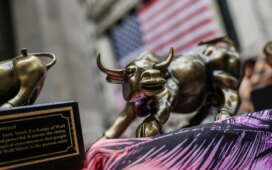Personal Finance

- Market timing is unreliable, and missing key market days can reduce long-term returns significantly.
- Dollar-cost averaging into Vanguard S&P 500 ETF (VOO) or Vanguard Total Stock Market ETF (VTI) helps mitigate the risk of buying at a high and smooths out volatility.
- Align investments with personal goals and maintain an emergency fund to balance risk and opportunity.
- Are you ahead, or behind on retirement? SmartAsset’s free tool can match you with a financial advisor in minutes to help you answer that today. Each advisor has been carefully vetted, and must act in your best interests. Don’t waste another minute; learn more here.(Sponsor)
The Perils of Market Timing
Attempting to time the stock market — waiting for the perfect moment to buy low and sell high — is a common but flawed investing strategy. It’s driven by the fear of buying at a peak or missing a dip,
Studies, like those from Vanguard, show that market timing often leads to worse returns than staying invested over time. The S&P 500, tracked by the Vanguard S&P 500 ETF (NYSEARCA:VOO), has historically delivered about 10% annualized returns over decades, but missing just a few of the best trading days can slash those gains significantly. Instead of trying to predict unpredictable market swings, being consistently in the market — through diversified ETFs like VOO or the Vanguard Total Stock Market ETF (NYSEARCA:VTI) — offers a more reliable path to wealth-building, leveraging long-term growth over short-term volatility.
Missing the VOO and VTI Dip
Recently, a Redditor on r/ETFs subreddit posted about their regret over missing the market dip earlier this year for VOO and VTI. They watched both ETFs hit lower prices but hesitated on buying, only to see prices rebound. Now, they’re torn: should they wait for another dip or jump in despite buying at a perceived high?
This is a classic investor’s conundrum, rooted in the fear of overpaying and the hope of catching a better price. The post sparked a lively discussion, with some users advocating for immediate investment and others suggesting waiting for a potential pullback. Let’s unpack this situation and offer practical insights for investors facing similar doubts.
VOO vs. VTI: Understanding the Options
Both VOO and VTI are low-cost, diversified ETFs from Vanguard, but they differ slightly. VOO tracks the S&P 500, covering 500 of the largest U.S. companies, offering exposure to about 80% of the U.S. stock market’s value. VTI, meanwhile, tracks the CRSP US Total Market Index, encompassing over 3,600 stocks, including small- and mid-cap companies, for broader market coverage.
As of today, both VOO and VTI have expense ratios of 0.03%, making both cost-effective. Historically, their performance is similar, with VOO slightly outperforming during large-cap rallies and VTI offering more diversification.
For someone like the Redditor, choosing between them depends on whether they prefer large-cap focus (VOO) or total market exposure (VTI). If I were advising a friend, I’d suggest VTI for its broader diversification, reducing risk from sector-specific downturns.
Dollar-Cost Averaging: A Smarter Entry Strategy
The Redditor’s fear of buying at a high is valid, but waiting for a dip can lead to paralysis. Markets are unpredictable — data from Morningstar shows that attempting to time entries often results in missed opportunities. A practical approach is dollar-cost averaging (DCA). Instead of going “all-in,” as the Redditor considered, DCA involves investing a fixed amount regularly — say, $500 monthly — into VOO or VTI. This spreads out the purchase price, reducing the impact of volatility.
For example, if VTI’s price fluctuates between $250 and $300 over six months, DCA averages the cost, mitigating the risk of buying at a peak. If I were in their shoes, I’d start with a small position now and commit to a DCA plan over 12 months to ease into the market.
Aligning with Your Financial Goals
The Reddit thread highlighted varied advice, but one recurring theme was the importance of strategy over emotion. Before investing, assess your risk tolerance and goals. Are you saving for retirement in 20 years, or a house in five? VOO and VTI suit long-term investors due to their stability and growth potential, but short-term volatility can be unnerving.
If I were guiding a family member, I’d suggest ensuring they have an emergency fund — three to six months of expenses — before investing heavily. This preserves liquidity if markets dip. Then, allocate investments based on goals: for example, 70% in VTI for growth, 20% in bonds for stability, and 10% cash for flexibility.
Don’t Wait for the Perfect Moment
The Redditor’s hesitation reflects a common trap: waiting for the “right” time. Because markets tend to rise over time, waiting for a dip can mean missing gains. For instance, from 2000 to 2020, the S&P 500 weathered crashes but still grew over 7% annually. If the Redditor waits, they risk missing further upside. My advice? Start small, use DCA, and focus on the long term.
Both VOO and VTI are solid choices for capturing U.S. market growth, and consistent investing trumps timing. They harness the power of long-term market growth, and with many reliable brokerages available, starting a disciplined investment plan today can pave the way for financial success. Choose one that aligns with your needs and take the first step toward building wealth.
Thank you for reading! Have some feedback for us?
Contact the 24/7 Wall St. editorial team.


